Grp78 heterozygosity regulates chaperone balance in exocrine pancreas with differential response to cerulein-induced acute pancreatitis
- PMID: 20971738
- PMCID: PMC2993313
- DOI: 10.2353/ajpath.2010.100368
Grp78 heterozygosity regulates chaperone balance in exocrine pancreas with differential response to cerulein-induced acute pancreatitis
Abstract
The endoplasmic reticulum (ER) is abundant in the acinar cells of the exocrine pancreas. To test the role of ER homeostasis in acute pancreatitis, we manipulated GRP78 levels, a major ER chaperone, in mice. Grp78(+/+) and (+/-) littermates were fed either a regular diet (RD) or a high-fat diet. Acinar cells were examined for ER structure by electron microscopy, and ER chaperone levels were assessed by immunoblotting. Pancreatitis was induced by cerulein injection, and multiple pathological parameters were analyzed. Grp78(+/-) mice showed decreased GRP78 expression in acinar cells. Exocrine pancreata of RD-fed Grp78(+/-) mice in an outbred C57BL/6 × 129/sv genetic background exhibited ER lumen dilation, a reduction in chaperones calnexin (CNX) and calreticulin (CRT), and exacerbated pancreatitis associated with high CHOP induction. With the high-fat diet regimen, Grp78 heterozygosity triggered GRP94 up-regulation and restoration of GRP78, CNX, and CRT to wild-type levels, corresponding with mitigated pancreatitis on cerulein insult. Interestingly, after backcrossing into the C57BL/6 background, RD-fed Grp78(+/-) mice exhibited an increase in GRP94 and levels of CNX and CRT equivalent to wild type, associated with decreased experimental pancreatitis severity. Administration of a chemical chaperone, 4-phenolbutyrate, was protective against cerulein-induced death. Thus, in exocrine pancreata, Grp78 heterozygosity regulates ER chaperone balance, in dietary- and genetic background-dependent manners, and improved ER protein folding capacity might be protective against pancreatitis.
Figures
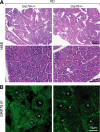
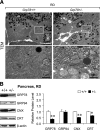
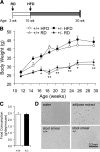
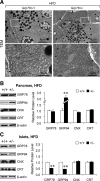

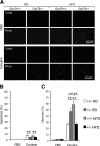
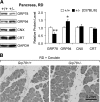

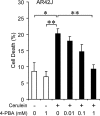
Similar articles
-
The ER chaperone GRP78 is associated with the severity of cerulein-induced pancreatic inflammation via regulating apoptosis of pancreatic acinar cells.Hepatogastroenterology. 2012 Sep;59(118):1670-6. doi: 10.5754/hge12281. Hepatogastroenterology. 2012. PMID: 22640899
-
Grp78 heterozygosity promotes adaptive unfolded protein response and attenuates diet-induced obesity and insulin resistance.Diabetes. 2010 Jan;59(1):6-16. doi: 10.2337/db09-0755. Epub 2009 Oct 6. Diabetes. 2010. PMID: 19808896 Free PMC article.
-
Oleic acid ameliorates palmitic acid-induced ER stress and inflammation markers in naive and cerulein-treated exocrine pancreas cells.Biosci Rep. 2019 May 14;39(5):BSR20190054. doi: 10.1042/BSR20190054. Print 2019 May 31. Biosci Rep. 2019. PMID: 30992393 Free PMC article.
-
Endoplasmic Reticulum Chaperones in Viral Infection: Therapeutic Perspectives.Microbiol Mol Biol Rev. 2021 Dec 15;85(4):e0003521. doi: 10.1128/MMBR.00035-21. Epub 2021 Oct 13. Microbiol Mol Biol Rev. 2021. PMID: 34643441 Free PMC article. Review.
-
The critical roles of endoplasmic reticulum chaperones and unfolded protein response in tumorigenesis and anticancer therapies.Oncogene. 2013 Feb 14;32(7):805-18. doi: 10.1038/onc.2012.130. Epub 2012 Apr 16. Oncogene. 2013. PMID: 22508478 Free PMC article. Review.
Cited by
-
Adiponectin is essential for lipid homeostasis and survival under insulin deficiency and promotes β-cell regeneration.Elife. 2014 Oct 23;3:e03851. doi: 10.7554/eLife.03851. Elife. 2014. PMID: 25339419 Free PMC article.
-
Protein quality control in the endoplasmic reticulum.F1000Prime Rep. 2014 Jul 8;6:49. doi: 10.12703/P6-49. eCollection 2014. F1000Prime Rep. 2014. PMID: 25184039 Free PMC article. Review.
-
GRP78 haploinsufficiency suppresses acinar-to-ductal metaplasia, signaling, and mutant Kras-driven pancreatic tumorigenesis in mice.Proc Natl Acad Sci U S A. 2017 May 16;114(20):E4020-E4029. doi: 10.1073/pnas.1616060114. Epub 2017 May 1. Proc Natl Acad Sci U S A. 2017. PMID: 28461470 Free PMC article.
-
Effects of Prolonged GRP78 Haploinsufficiency on Organ Homeostasis, Behavior, Cancer and Chemotoxic Resistance in Aged Mice.Sci Rep. 2017 Feb 1;7:40919. doi: 10.1038/srep40919. Sci Rep. 2017. PMID: 28145503 Free PMC article.
-
Genetic polymorphisms of Ca2+ transport proteins and molecular chaperones in mitochondria-associated endoplasmic reticulum membrane and non-alcoholic fatty liver disease.Front Endocrinol (Lausanne). 2023 Jan 4;13:1056283. doi: 10.3389/fendo.2022.1056283. eCollection 2022. Front Endocrinol (Lausanne). 2023. PMID: 36686460 Free PMC article.
References
-
- Case RM. Synthesis, intracellular transport and discharge of exportable proteins in the pancreatic acinar cell and other cells. Biol Rev Camb Philos Soc. 1978;53:211–354. - PubMed
-
- Lee AS. The ER chaperone and signaling regulator GRP78/BiP as a monitor of endoplasmic reticulum stress. Methods. 2005;35:373–381. - PubMed
-
- Hendershot LM. The ER function BiP is a master regulator of ER function. Mt Sinai J Med. 2004;71:289–297. - PubMed
Publication types
MeSH terms
Substances
Grants and funding
LinkOut - more resources
Full Text Sources
Medical
Molecular Biology Databases
Research Materials
Miscellaneous

